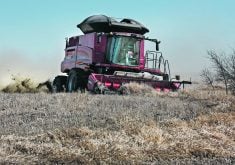Soil nutrients down
Nutrient levels appear to be down in fields across the Prairies, according to Alberta Agriculture analysts. That makes soil testing important to a good 1994 crop.
“Available nitrogen levels are close to zero in most stubble fields this spring and fallow fields are also low in available nitrogen in many parts of the province,” said Dan Heaney of Alberta Agriculture.
One private company analyzed tonnes of soils from Manitoba, Saskatchewan and Alberta last fall and recorded lower nutrient levels than in previous years. Heaney said soil tests are the only way farmers can determine the exact needs of their soil. Nitrogen and phosphorus appear to be the main nutrients with greater-than-normal depletion.
Read Also

VIDEO: Green Lightning and Nytro Ag win sustainability innovation award
Nytro Ag Corp and Green Lightning recieved an innovation award at Ag in Motion 2025 for the Green Lightning Nitrogen Machine, which converts atmospheric nitrogen into a plant-usable form.
Facilities expanded
DowElanco Canada Inc. will expand its manufacturing and distribution facility at Fort Saskatchewan, Alta.
A 60,000 square-foot warehouse will be built next to the existing plant and is expected to be finished by the end of 1994. Rudy Fast of DowElanco said the expansion is needed due to increased demand for granular fertilizer.
Pale pork problem
Pale, soft pork results in an estimated $20 million loss to the pork industry annually, according to Saskatchewan Agriculture scientists. They recently completed a study on the effects of pre-slaughter conditions on ultimate pork quality.
Genetics were found to play a major role, but so does pre-slaughter handling of pigs, the study showed. While pH levels usually drop after slaughter, in some pigs it drops too rapidly, creating an unpleasant color, texture and loss of water in the meat.
Further research is needed to determine the best diet for hogs before slaughter, the study concluded.
John Patience, president of Prairie Swine Centre, says economic losses from pale, soft pork are partly due to consumer avoidance of the product. But the extra water loss of such pork also means retailers suffer when meat they sell weighs less than meat they bought.














